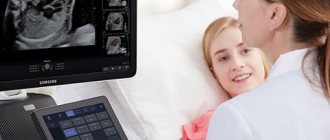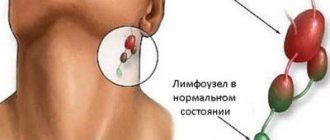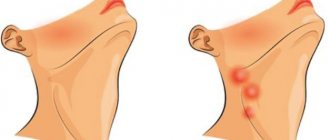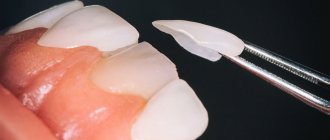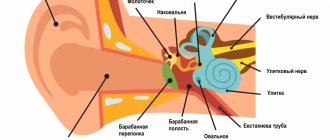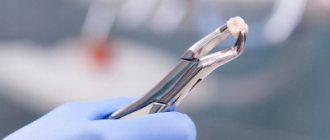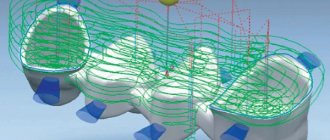General information
The organs of the lymphatic system play a protective role in the human body. They serve as a barrier to viruses, bacteria, and also filter out harmful substances. In total, there are more than 450 lymph nodes in the adult body, and their maximum number is formed by the age of 10.
Lymph nodes are connected by lymphatic vessels - lymph (a fluid with a high content of lymphocytes, or “white blood cells”) circulates through them. Produced in the bone marrow, lymphocytes circulate throughout the body, first passing through the spleen and then the lymph nodes. Thanks to this, they gain the ability to produce antibodies to destroy microbes. Source: A.G. Rumyantsev, professor, V.M. Chernov, professor, V.M. Delyagin, professor Enlarged lymph node syndrome as a pediatric problem Practical Medicine, 2007, No. 5 (24), pp. 12-15
When an infection enters , a kind of “attack” is carried out on it, as a result of which the lymph nodes can enlarge (during this period they more actively produce antibodies). After recovery, the nodes return to normal size. If their diameter and density do not return to their original state, the child must be shown to a doctor.
Causes
Teething may be the cause of nonspecific submandibular lymphadenitis in a child
Submandibular lymphadenitis in children is caused by the fact that lymph nodes up to 10 years of age are involved in almost all inflammatory processes, since they are one of the links in protective mechanisms.
They are extremely sensitive to:
- any foreign elements in the body;
- bacteria or viruses;
- toxic substances;
- particles that form during the breakdown of tissues or cells.
This happens due to the fact that the lymph nodes capture these elements, preventing their spread through the blood and lymphatic channels. As a rule, lymphadenitis occurs for nonspecific reasons, for example, the spread of pathogenic microflora, often various cocci. In this case, the infection enters the blood from the main source, which leads to enlargement and pain of the lymph nodes.
Important. About 70% of submandibular lymphadenitis in childhood is caused by otorhinolaryngological diseases: tonsillitis, sinusitis and otitis media.
At the age of 6-7 years, inflammation of the lymph nodes is often associated with dental pathologies (pulpitis, periodontitis, osteomyelitis), and discomfort often occurs after the primary lesion has subsided.
Other causes of lymphadenitis:
- teething;
- skin infections;
- infectious diseases of any nature and origin (influenza, scarlet fever, measles, ARVI and others);
- leukemia;
- oncological diseases;
- chronic diseases of the gastrointestinal tract;
- lymphatic-hypoplastic diathesis;
- herpes virus infections.
The note. If the lymph nodes are mechanically injured, they can become inflamed.
Specific lymphadenitis is caused by:
- tuberculosis;
- syphilis;
- mononucleosis of infectious nature;
- actinomycosis;
- brucellosis and others.
Indicators of normal lymph nodes:
- diameter up to approximately 5 mm;
- soft consistency;
- single location, that is, lack of connection with each other or with the skin;
- absence of pain upon palpation (palpation);
- mobility.
Reasons for enlargement and main groups of lymph nodes
| Group of lymph nodes | Typical reasons for the increase |
| Parotid | Pyoderma (inflammation of the scalp accompanied by pus), inflammation of the outer or middle ear, the presence of lice, atopic dermatitis, eczema. |
| Occipital | Various inflammations in the scalp, fungal diseases, rubella, etc. |
| Submental | Abscess of the jaw, inflammation of the lower lip, damage to the front teeth, stomatitis. |
| Submandibular | Gingivitis, stomatitis, dental damage. |
| Cervical (in the direction of the muscles at the back of the neck) | Sore throat, chronic tonsillitis, tuberculosis of the tonsils, adenoids, infectious form of mononucleosis. |
| Cervical (middle) | Scarlet fever, tonsillitis, “cat scratch disease”, Hodgkin or non-Hodgkin lymphoma ( important - these are malignant oncological processes!), toxoplasmosis. |
| Cervical (lateral) | Tumors, lymph node tuberculosis, nasopharyngeal infections. |
| Elbow | Infections of the forearm or hand. |
| Axillary | Shoulder or arm infections, vaccine reactions, cat scratch disease. |
| Inguinal | Infections of the skin, bones and muscles of the lower extremities, inflammation of the joints, dermatitis, inflammatory processes in the genitals, reaction to a vaccine introduced into the femoral area. |
Enlarged lymph nodes
Enlargement of the submandibular lymph nodes (submandibular lymphadenopathy) is the presence of lymphoid formations with a diameter of more than 0.5 cm at the edge of the lower jaw. The affected nodes have a tight-elastic or stony consistency. The symptom is observed in acute respiratory viral infections, diseases of the tonsils, infectious, dental and oncological pathologies. To clarify the cause of submandibular lymphadenopathy, ultrasound, lymphography, CT, MRI, lymph node biopsy, laboratory tests, and instrumental examinations by specialized specialists are prescribed. To alleviate the condition, analgesics are used; for obvious signs of acute respiratory viral infections, sore throats, tonsillitis and stomatitis, rinsing the mouth with antiseptics is recommended.
Oncological alertness
Lymph nodes are often enlarged due to lymphogranulomatosis (Hodgkin's lymphoma) or lymphosarcoma (non-Hodgkin's lymphoma). These are malignant processes that are manifested by increased density, painlessness and large diameter of the lymph nodes in the absence of other reasons for their deformation. Lymph nodes enlarge in groups, asymmetrically (for example, on one side of the neck). At the initial stage of the process, their mobility and separate arrangement are maintained. If the oncological process continues without treatment, the lymph nodes may become fused, and moderate pain rarely occurs. Source: N.V. Nagornaya, E.V. Vilchevskaya, A.P. Luachak, E.N. Marchenko, E.V. Bordyugova, A.P. Koval Hodgkin's disease (lymphogranulomatosis) in children // Child's Health, 2013, No. 1 (44), pp. 13-15
Symptoms that require consultation with a doctor are enlarged lymph nodes:
- more than 7 days;
- more than 1 group;
- accompanied by elevated body temperature;
- in a child under one year old;
- progressive over time;
- with changes in local skin.
Symptoms, photos and diagnosis of submandibular lymphadenitis
Submandibular lymphadenitis can be distinguished from the usual enlarged lymph nodes, which occurs with reduced immunity, by the presence of pain and compaction. If there is no pain when you touch the node and the lump is not palpable, its enlargement may be caused by decreased immunity. A compacted lymph node can signal the development of oncology, so if it is detected, it is necessary to urgently be examined by a doctor.
Submandibular lymphadenitis is characterized by enlarged lymph nodes, but it is not the main symptom. For a doctor to suspect lymphadenitis, at least one of the following signs must appear:
- Pain syndrome. In the early stages of the development of the disease, aching, nagging pain of high intensity is noted in the lower part of the head - under the lower jaw. Severe pain is felt when lightly pressing on the lymph node, during chewing, when yawning, or turning the head. As the disease progresses, pain during palpation increases, and then at rest. Patients are unable to relieve pain on their own.
- Significant enlargement of the lymph node and severe swelling, which makes swallowing difficult and provokes a feeling of fullness in the sublingual area. When swallowing, there is a feeling that a piece of food is too large. Speech becomes difficult.
- Labored breathing. It occurs gradually and is accompanied by cyanosis of the nasolabial triangle and pallor of the skin of the face.
- Visually noticeable swelling under the cheek. The size of the compaction depends on the severity of the ongoing pathological process, the amount of serous fluid and pus.
- An increase in body temperature to 39–40 °C, which may be accompanied by severe headache and sweating. This temperature is difficult to reduce with conventional antipyretics.
- Redness of the skin above and around the node. If pus has accumulated in the node, the skin around it will acquire a pronounced purple tint.
An accumulation of pus can be detected by palpation; pus can be felt even through the texture of the skin and node.
If there are signs of inflammation of the submandibular lymph node, you should seek help from a doctor. The treatment of lymphadenitis is carried out by therapists, otolaryngologists and surgeons.
Photo: chronic inflammation of the lymph node
Photo: acute inflammation of the lymph node
In addition to visual inspection and palpation of the node, doctors use several other clinical diagnostic methods:
- General blood analysis. With the development of submandibular lymphadenitis, there is a significant increase in the level of leukocytes in the blood.
- Ultrasonography. Allows you to detect the presence of pus and serous fluid inside the lymph node.
- Bacteriological analysis of fluid from a lymph node. Allows you to determine the type of bacteria that caused the inflammation and select the most effective antibiotics.
- Carrying out a complete differential (excluding other diseases) diagnosis. It is necessary due to the similarity of the symptoms of submandibular lymphadenitis with other diseases: inflammation of the salivary glands, adenoiditis.
To prescribe the correct treatment, it is necessary to identify the form of the disease and determine the severity of the pathological process.
Diagnostic methods
After examination and collection of complaints and medical history, the specialist sends the child for a general examination . It includes x-rays, blood and urine tests . Additionally, the following studies may be needed:
- blood serology;
- diagnosis of tuberculosis;
- lymph node biopsy followed by cytological examination in the laboratory;
- Ultrasound.
Sometimes children are prescribed antibacterial drugs as part of the diagnosis. Based on their effectiveness, they confirm or refute the bacterial nature of the disease.
Treatment methods
Enlarged lymph nodes are not an independent disease, but a symptom of some other disease. Therefore, therapy in this case comes down to eliminating the root cause of this reaction. The rate at which nodes return to normal size varies, depending on the severity and type of underlying disease.
If a child gets sick very often, then immunomodulators are recommended to strengthen the body's defenses. The choice of drug should be made only by a doctor.
Important! Enlarged lymph nodes should not be heated - this can lead to the development of suppuration and blood poisoning! Any self-medication is prohibited - the reason and type of therapy is determined by a specialist.
Treatment
Therapeutic tactics are determined by the stage of the pathology, the nature of the pathogenesis, the condition of the child and the type of primary inflammation. It is important not only to eliminate the symptoms, but also to overcome the infectious elements that led to this condition.
In case of purulent lymphadenitis, surgical intervention is indicated to cleanse and antiseptic the lesion
Conservative treatment is possible for serous and chronic nonspecific lymphadenitis, for this purpose the following is prescribed:
- antibacterial drugs: cephalosporins, macrolides and others;
- desensitizing agents;
- physiotherapeutic procedures: UHF, heating, compresses, etc.;
- mineral and vitamin complexes;
- immunomodulators;
- restoratives.
If a purulent process is diagnosed or conservative therapy does not help, then treatment is continued in a hospital setting. Through surgery, the diseased lymph node is opened and cleaned; if necessary, the lymph node is completely removed. During the rehabilitation period, detoxification and anti-inflammatory drugs are prescribed.
Note. In the presence of submandibular lymphadenitis in children of tuberculous etiology, treatment is carried out in special hospitals.
Advantages of contacting SM-Clinic
“SM-Clinic” is a team of some of the best specialists in St. Petersburg, advanced diagnostic equipment and comfortable conditions. We have no queues, all examinations are carried out quickly, appointments are conducted by highly qualified doctors.
If your child has enlarged lymph nodes in the neck or in any other area, you should urgently contact a specialist for diagnosis and treatment. Delay in some cases is very dangerous!
To make an appointment with a pediatrician, immunologist or other pediatric specialist, call us.
Sources:
- A.G. Rumyantsev, professor, V.M. Chernov, professor, V.M. Delyagin, professor. Syndrome of enlarged lymph nodes as a pediatric problem // Practical Medicine, 2007, No. 5 (24), pp. 12-15.
- N.V. Nagornaya, E.V. Vilchevskaya, A.P. Luachak, E.N. Marchenko, E.V. Bordyugova, A.P. Koval. Hodgkin's disease (lymphogranulomatosis) in children // Child's Health, 2013, No. 1 (44), pp. 13-15.
Grek Elena Anatolyevna Clinic
Author of the article
Grek Elena Anatolyevna
Doctor of the highest qualification category
Specialty: immunologist
Experience: 24 years
The information in this article is provided for reference purposes and does not replace advice from a qualified professional. Don't self-medicate! At the first signs of illness, you should consult a doctor.
Prices
| Name of service (price list incomplete) | Price |
| Appointment (examination, consultation) with an allergist-immunologist, primary, therapeutic and diagnostic, outpatient | 1750 rub. |
| Consultation (interpretation) with analyzes from third parties | 2250 rub. |
| Prescription of treatment regimen (for up to 1 month) | 1800 rub. |
| Prescription of treatment regimen (for a period of 1 month) | 2700 rub. |
| Consultation with a candidate of medical sciences | 2500 rub. |
| Allergen-specific immunotherapy (ASIT) - maintenance course (excluding the cost of the drug) | 8100 rub. |
